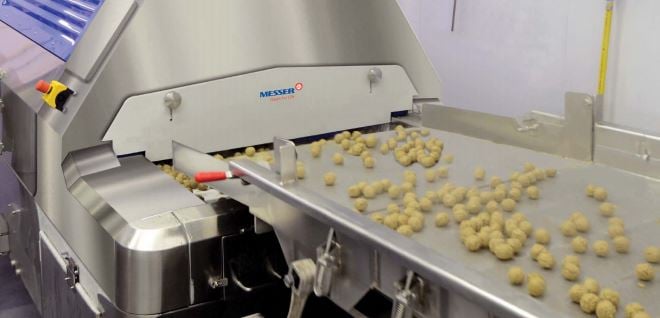Consumers are stocking up on refrigerated and frozen foods during the COVID-19 crisis, and at the same time the meat & poultry industry has been hit especially hard with plant shutdowns and labor issues. When considering their food chain, food processors can take action now to be ready to bounce back, particularly as the country is beginning to re-open.
Most producers of chilled and frozen foods rely on cryogenic gases for high yield at high production rates, and plants are usually equipped with either liquid carbon dioxide (CO2) or liquid nitrogen (N2). But now is a good time to consider using both or to switch to N2 where possible – for added convenience, flexibility and protection against a possible CO2 shortage – at a comparable cost.
Make no mistake, Messer is still a leading supplier of CO2 in the U.S. and the many nodes of our supply network give us increased flexibility for uncertain times. We are also substantially less dependent on CO2 from ethanol than other major CO2 suppliers.
Many of our largest customers are food processors, and we are intimately involved in their operations. Yet N2 can be just as effective, if not more so than CO2, for chilling and freezing food. Nitrogen is liquid at -320.8 °F, and it removes heat with much colder temperatures.
Messer directly controls the production of CO2 and N2 and operates multiple Air Separation Units (ASUs) in North America. Our vast network affords our customers an increased level of reliable supply, coupled with significant storage capacity at each site.
Cryogenic Food Processing
Most applications can use either cryogen. For example, blended foods, such as formed poultry products, can benefit from mixer chilling from the bottom of the mixer with injections of either liquid N2 or CO2. Our hygienic KRYOJECTOR™ bottom-injection system can greatly improve mixer chilling cycle times and improve food safety by eliminating product entrapment found in open-orifice nozzles.
In addition, immersion in liquid nitrogen (LIN) is still the fastest way to freeze, and most cryogenic freezers can operate with LIN and can easily be converted from CO2. New freezers are highly efficient and can offer useful advantages for “the new normal.” The new Messer Wave Impingement Freezer, for example, gives processors the ability to process a variety of foods with one machine. And our nitrogen “Hot Products Freezer” eliminates ice buildup, a common occurrence with many existing freezers.
Converting from CO2 to N2
Our application sales engineers can help processors decide which cryogen is right for their plants. Selecting the optimal cryogen and process can have a major impact on a company’s bottom line, and there are many factors to consider, including:
- type of foods and food ingredients
- existing chilling and freezing equipment
- the production line and other plant processes
- current and estimated cost to freeze or chill
Nitrogen can be retrofitted to most existing equipment or installed on new freezers and chilling systems. New N2 installations are typically completed, including operator and safety training, in about two weeks, though final hookups usually require only a matter of days. In some cases, the latter can be completed over a long weekend to ease the transition.
No one knows exactly how long the impact of the COVID-19 crisis will last. However, those processors that can respond in the face of disruption and uncertainty will likely be in the best position to emerge stronger than before. For more information about Messer or to schedule a consultation, please visit www.messer-us.com, or call 800-755-9277.



Comments
Messer makes no warranty of any kind with respect to the subject matter, the completeness, or accuracy of this blog. Messer is not responsible for any actions (or lack thereof) taken as a result of relying on or in any way using information contained in this blog. In no event shall Messer be liable for any damages resulting from reliance on or use of information in this blog. Readers should take advice from a qualified professional when dealing with specific situations. Descriptions of, or references or access to, other publications within this blog do not imply endorsement of those publications. This blog may contain technical inaccuracies and changes to the information may be made at any time.
Gas products are hazardous. The use or misuse of gas products involves serious risks, including injury, disability and death. Users of gas products must use the Safety Data Sheets for the gas products to warn their employees and others who are exposed to the gas products or hazards associated with such products.